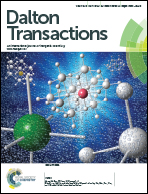Metal effects on ligand non-innocence in Group 5 complexes of the redox-active [ONO] pincer ligand†
Abstract
Isostructural vanadium, niobium and tantalum complexes of bis(3,5-di-tert-butyl-2-phenol)amine ([ONO]H3), were prepared and characterized to evaluate the impact of the metal ion on redox-activity of the ligand platform. New vanadium and niobium complexes with the general formula, [ONO]MCl2L (M = V, L = THF, 1-V; M = Nb, L = Et2O, 1-Nb) were prepared and structurally analysed by X-ray crystallography. The solid-state structures indicate that the niobium derivative is electronically analogous to the tantalum analog 1-Ta, containing a reduced (ONO) ligand and a niobium(V) metal ion, [ONOcat]NbVCl2(OEt2); whereas, the vanadium derivative is best described as a vanadium(IV) complex, [ONOsq]VIVCl2(THF). One-electron oxidation was carried out on all three metal complexes to afford [ONO]MCl3 derivatives (3-V, 3-Nb, 3-Ta). For all three derivatives, oxidation occurs at the (ONO) ligand. In the cases of niobium and tantalum, electronically similar complexes characterized as [ONOsq]MVCl3 were obtained and for vanadium, ligand-based oxidation led to the formation of a complex best described as [ONOq]VIVCl3. All complexes were characterized by spectroscopic and electrochemical methods. DFT and TD-DFT calculations were used to probe the electronic structure of the complexes and help verify the different electronic structures stemming from changes to the coordinated metal ion.
![Graphical abstract: Metal effects on ligand non-innocence in Group 5 complexes of the redox-active [ONO] pincer ligand](/en/Image/Get?imageInfo.ImageType=GA&imageInfo.ImageIdentifier.ManuscriptID=C4DT02259A&imageInfo.ImageIdentifier.Year=2014)

 Please wait while we load your content...
Please wait while we load your content...